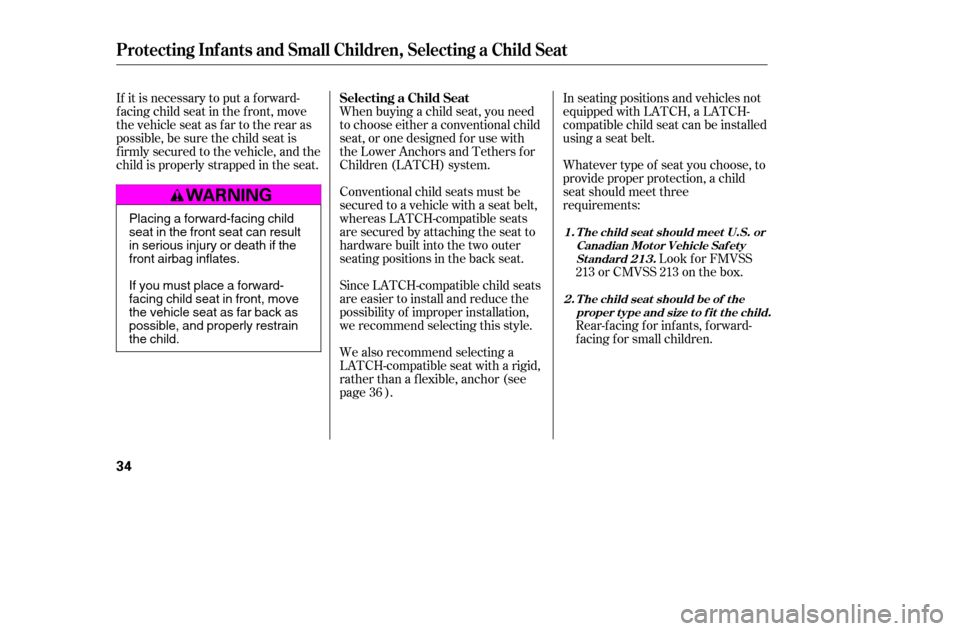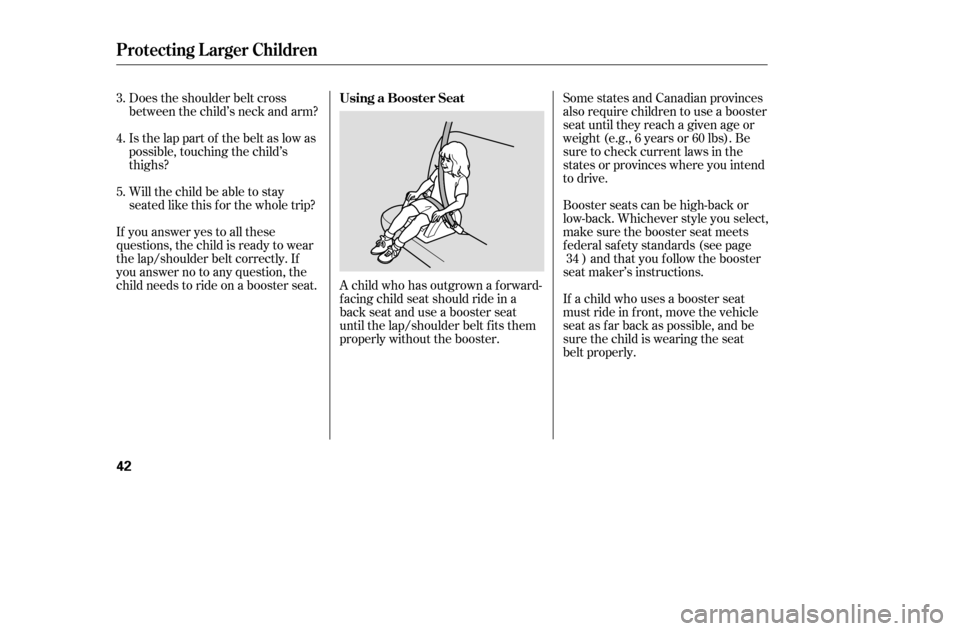Page 31 of 226

In seating positions and vehicles not
equipped with LATCH, a LATCH-
compatible child seat can be installed
using a seat belt.
Whatever type of seat you choose, to
provide proper protection, a child
seat should meet three
requirements:Look f or FMVSS
213 or CMVSS 213 on the box.
Rear-facing for infants, forward-
f acing f or small children.
If it is necessary to put a f orward-
f acing child seat in the f ront, move
the vehicle seat as far to the rear as
possible, be sure the child seat is
f irmly secured to the vehicle, and the
child is properly strapped in the seat.
We also recommend selecting a
LATCH-compatible seat with a rigid,
rather than a f lexible, anchor (see
page ).
Since LATCH-compatible child seats
are easier to install and reduce the
possibility of improper installation,
we recommend selecting this style.
Conventional child seats must be
secured to a vehicle with a seat belt,
whereas LATCH-compatible seats
are secured by attaching the seat to
hardware built into the two outer
seating positions in the back seat.
When buying a child seat, you need
to choose either a conventional child
seat, or one designed f or use with
the Lower Anchors and Tethers f or
Children (LATCH) system.
36
T he child seat should meet U.S. orCanadian Mot or Vehicle Saf et ySt andard 213.
T he child seat should be of theproper t ype and size t o f it t he child.
1.
2.
Protecting Inf ants and Small Children, Selecting a Child Seat
Selecting a Child Seat
34
Placing a forward-facing child
seat in the front seat can result
in serious injury or death if the
front airbag inflates.
Ifyoumustplaceaforward-
facing child seat in front, move
the vehicle seat as far back as
possible, and properly restrain
the child.
�����—�����—�����y�
���������
���y���
�(���%�������y���������y
Page 32 of 226

Af ter selecting a proper child seat,
and a good place to install the seat,
there are three main steps in
installing the seat:All child seats must be
secured to the vehicle with the lap
part of a lap/shoulder belt or with
the LATCH (Lower Anchors and
Tethers f or Children) system. A
child whose seat is not properly
secured to the vehicle can be
endangered in a crash.
Af ter installing a child
seat, push and pull the seat
f orward and f rom side to side to
verif y that it is secure.
A child seat secured with a seat belt
should be installed as f irmly as
possible. However, it does not need
to be ‘‘rock solid.’’ Some side-to-side movement can be expected and
should not reduce the child seat’s
ef f ectiveness.
If the child seat is not secure, try
installing it in a dif f erent seating
position, or use a dif f erent style of
child seat that can be f irmly secured.
Make sure the child is properly
strappedinthechildseat
according to the child seat maker’s
instructions. A child who is not
properly secured in a child seat
can be seriously injured in a crash.
The f ollowing pages provide
guidelines on how to properly install
a child seat. A f orward-f acing child
seat is used in all examples, but the
instructions are the same f or rear-
f acing child seats.
Bef ore purchasing a conventional
child seat, or using a previously
purchased one, we recommend that
you test the seat in the specif ic
vehicle seating position (or
positions) where the seat will be
used.
Selecting a Child Seat, Installing a Child Seat
Installing a Child Seat
Properly secure t he child seat t o
the vehicle.
Make sure t he child seat is f irmlysecured. Secure the child in the child seat.
T he child seat should f it the
vehicle seat ing posit ion (orposit ions) where it will be used.
1.
2. 3.
3.
Driver and Passenger Saf ety
35
�����—�����—�����y�
�������������y���
�(���%�������y���������y
Page 33 of 226
Place the child seat on the vehicle
seat, then attach the seat to the
lower anchors according to the
child seat maker’s instructions.
Your vehicle is equipped with
LATCH (Lower Anchors and
Tethers for Children) at the outer
rear seats.
The lower anchors are located
between the seat-back and seat
bottom, and are to be used only with
a child seat designed f or use with
LATCH.
The location of each lower anchor is
indicated by a small button above the
anchor point.
Make sure there are no objects
near the anchors that could
prevent a secure connection
between the child seat and the
anchors.
Move the seat belt buckle or
tongue away f rom the lower
anchors.
To install a LATCH-compatible child
seat:
Some LATCH-compatible seats
have a rigid-type connector as
shown above.
1. 2. 3.
Installing a Child Seat
Installing a Child Seat with
LATCH
36
LOWER ANCHORS
Rigid type
BUTTONS
�����—�����—�����y�
�������������y���
�(���%�������y���������y
Page 34 of 226
Whatever type you have, f ollow
the child seat maker’s instructions
f or adjusting or tightening the f it.
Other LATCH-compatible seats
have a f lexible-type connector as
shown above.
Lif t the head restraint (see page
), then route the tether strap
through the legs of the head
restraint, over the seat-back,
making sure the strap is not
twisted.
Attach the tether strap hook to the
tether anchor, then tighten the
strap as instructed by the child
seat maker. Push and pull the child seat
f orward and f rom side to side to
verif y that it is secure.
4. 6.
5. 7.
75
Installing a Child Seat
Driver and Passenger Saf ety
37
Flexible type ANCHOR
TETHER STRAP HOOK
�����—�����—�����y�
�������������y���
�(���%�������y���������y
Page 35 of 226
To activate the lockable retractor,
slowly pull the shoulder part of the
belt all the way out until it stops,
then let the belt f eed back into the
retractor.
Af ter the belt has retracted, tug on
it. If the belt is locked, you will not
be able to pull it out. If you can pull
thebeltout,itisnotlocked,and
you will need to repeat these steps.
When not using the LATCH system,
all child seats must be secured to the
vehicle with the lap part of a lap/
shoulder belt.
With the child seat in the desired
seating position, route the belt
through the child seat according
to the seat maker’s instructions,
then insert the latch plate into the
buckle.
In addition, the lap/shoulder belts in
all seating positions except the
driver’s have a locking mechanism
that must be activated to secure a
child seat.
1.2. 3.
Installing a Child Seat
Installing a Child Seat with a Seat
Belt
38
�����—�����—�����y�
�������������y���
�(���%�������y�������
�y
Page 39 of 226

Does the shoulder belt cross
between the child’s neck and arm?
Is the lap part of the belt as low as
possible, touching the child’s
thighs?
Will the child be able to stay
seated like this f or the whole trip?
If you answer yes to all these
questions, the child is ready to wear
the lap/shoulder belt correctly. If
you answer no to any question, the
child needs to ride on a booster seat. A child who has outgrown a f orward- f acing child seat should ride in a
back seat and use a booster seat
until the lap/shoulder belt f its them
properly without the booster.Some states and Canadian provinces
also require children to use a booster
seat until they reach a given age or
weight (e.g., 6 years or 60 lbs). Be
sure to check current laws in the
states or provinces where you intend
to drive.
Booster seats can be high-back or
low-back. Whichever style you select,
make sure the booster seat meets
f ederal saf ety standards (see page
) and that you f ollow the booster
seat maker’s instructions.
If a child who uses a booster seat
must ride in f ront, move the vehicle
seat as far back as possible, and be
sure the child is wearing the seat
belt properly.
3. 4. 5.
34
Protecting L arger Children
Using a Booster Seat
42
�����—�����—�����y�
�������������y���
�(���%�������y���������y
Page 69 of 226
�µ
To change the seat-back angle, pull
up on the lever on the outside of the
seat bottom.
Make all seat adjustments bef ore
you start driving.
To adjust the seat forward and
backward, pull up on the bar under
the seat cushion’s f ront edge. Try to
movetheseattomakesureitis
locked in position.
See pages f or important saf etyinf ormation and warnings about how toproperly position the seats and seat-
backs. 11 13
FrontSeatAdjustments
Seats
Inst rument s and Cont rols
73
�����—�����—�����y�
�������������y���
�(���%�������y���������y
Page 70 of 226
To get into the rear seat on the
driver’s side, pull up on the seat-back
adjustment lever.On all other models, push down the
release lever at the base of the seat-
back. The seat-back will tilt f orward
and the whole seat will slide f orward.
The height of the driver’s seat is
adjustable. Turn the dial on the
outside of the seat cushion. To get into the rear seat f rom the
passenger’s side in the U.S. DX and
Value Package models, pull up the
seat-back adjustment lever. The seat-
back will tilt f orward. If more room is
needed, use the seat adjustment bar
to move the seat forward.If equipped
Driver’s Seat Height Adjustment Rear Seat Access
Seats
74
RELEASE
LEVER
SEAT-BACK
ADJUSTMENT LEVER
�����—�����—�����y�
�������������y���
�(���%�������y���������y